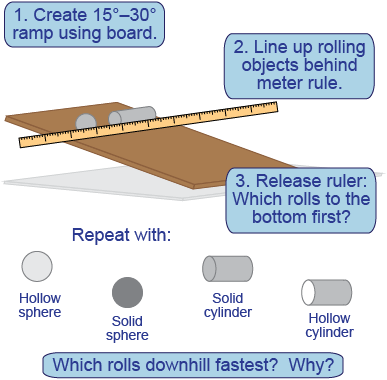| | Essential questions | | What is moment of inertia (or rotational inertia)?
What physical quantities determine the rotational inertia of an object? | |
|
Galileo demonstrated the principle that objects are all accelerated at the same rate by gravity, regardless of their mass. But do all objects roll downhill with identical acceleration? In this investigation, you will roll a number of different objects down a ramp and determine which one—if any!—is accelerated the most. Each of the objects has a different distribution of mass within it; some are hollow whereas others are solid, for example. Does the distribution of mass within an object change its rotational properties? 
|
You will need the following materials: - a stiff board (wood, foam, etc.) and a support to make a ramp;
- a meter rule, to use as the starting gate;
- different shapes of rolling objects, such as a solid metal can, which has relatively solid contents (not soup), a hollow metal can, a solid ball, and a hollow ball; and
- additional examples of the same geometrical shapes, but having different masses and radii.

|
Which object rolls downhill the fastest?

- Prop up a stiff board with a support to form a ramp with an inclination angle of 15°–30°.
- Line up the meter rule across the board to use it as a starting gate, and place two (or more) objects behind it.
- Lift up the meter rule to start the objects rolling and note which one reaches the bottom first.
- Repeat for all four geometrical shapes: a solid sphere, a hollow sphere (ball), a solid cylinder, and a hollow cylinder (ring).

- Which of the four geometrical shapes reaches the bottom first? Last? List them in order from fastest to slowest.
- What is the equation for the moment of inertia of each geometrical shape?
- Explain why you think that the objects reached the bottom in that order.
- For two objects of the same shape but different radii, will they reach the bottom at the same time? Design and carry out an experiment to test your prediction.
- For two objects of the same shape but different masses, will they reach the bottom at the same time? Design and carry out an experiment to test your prediction.

| |
| |
|

